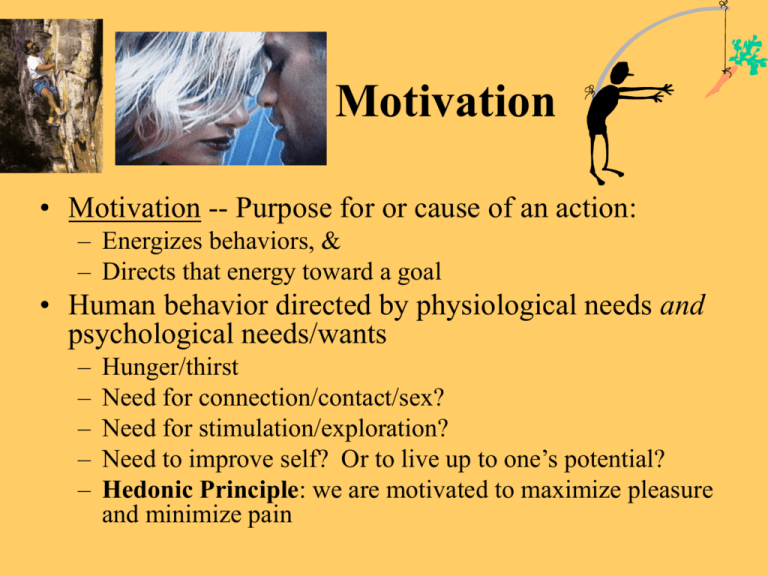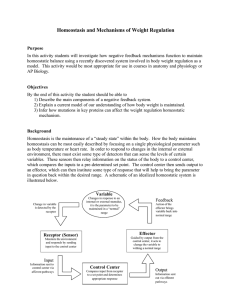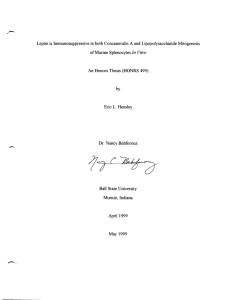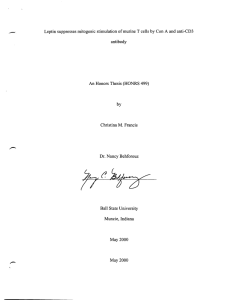
Motivation
• Motivation -- Purpose for or cause of an action:
– Energizes behaviors, &
– Directs that energy toward a goal
• Human behavior directed by physiological needs and
psychological needs/wants
–
–
–
–
–
Hunger/thirst
Need for connection/contact/sex?
Need for stimulation/exploration?
Need to improve self? Or to live up to one’s potential?
Hedonic Principle: we are motivated to maximize pleasure
and minimize pain
Abraham Maslow’s theory
Love in bloom
• Amidst the festivities of a grand party, a young
guy notices a strikingly beautiful girl and is
immediately smitten….
• He approaches her and begins to flirt boldly….
She tries to rebuff him but is flattered by his
attention and finds him quite attractive…
Romantic feelings kindle rapidly….
• By the time he departs the scene, with a kiss
followed by a second kiss, these two have
exchanged fewer than a hundred words; yet, both are
swooning with sensations of falling, desperately,
in love.
• All mental processes – thinking, planning, goals,
feelings, and motivations – have been suddenly
transformed….these brains have been completely
gripped by this brief encounter.
Longing, obsession, and
desire…
• In the hours after this meeting, these two can not stop
thinking about each other
• The intensity of desire is so strong that each would happily
forego food, sleep, comfort, and all competing pleasures,
simply to be in each other’s presence again
Shakespeare (1595) was dramatizing one of the normal tensions of
adolescence and development of sexual motivations.
•GET READY, HERE
COMES A GRAPHIC
PICTURE OF YOUR
SEX ORGAN!!!!!
•Energizing and directing arousal
•Interplay of internal and external stimuli
•Internal: Hormones, brain structures,
neurotransmitters, imagined stimuli
•External: Environmental and
sociocultural factors
Hormones and Sexual
Motivation
•Dihydroepiandosterone (dhea)
seems to be involved in initial onset
of sexual desire
•Both males and females produce
testosterone and estrogen
• Testosterone: involved in sex
drive for both men and women
•Estrogen: in female mammals,
estrogen levels peak during
ovulation, promoting sexual
receptivity (but not a major factor
in human females)
Key brain regions mediating
human sexual behavior
• Subcortical
– Septal region -- Pleasurable response and orgasm
– Hypothalamus -- Neuroendocrine and autonomic
aspects of sexual drive, sexual orientation
• Cortical
– Frontal lobes -- Motor components of sexual behavior,
control of sexual response (disinhibition)
– Parietal lobes -- Genital sensation
– Temporal lobes: sexual drive (hypo/hypersexuality,
impotence)
– Baird et al., 2007 J of Neurology, Neurosurgery, and Psychiatry
Desire Phase
Resolution
Arousal - Excitement
Plateau
Orgasm
Motivation for Eating
• As with sex, eating is an
interplay of internal and
external stimuli
– Internal: Hormones, brain
structures,
neurotransmitters,
imagined stimuli
– External: Environmental
and sociocultural factors
• Primary receiver of
hunger signals is
hypothalamus
12
Genetic influences on eating
• ob gene
– Regulates production of leptin
– Leptin is secreted by fat cells and has dual
activity of decreasing food intake and
increasing metabolic rate
– Mice born without the ability to make leptin
(ob/ob mice) eat without restraint
ob/ob mouse
normal mice
ob/ob mouse
ob/ob mouse
ob/ob mouse
injected with
leptin
So, just give obese
humans leptin!
• In fact, this works in leptin-deficient
humans, but…
• 99.99% of obese humans have HIGH levels
of leptin, but have become insensitive to it.
• Something else is going on… (obesity trends
powerpoint)
Other kinds of motivation
• Extrinsic motivation
• Intrinsic motivation
– extrinsic motivators can harm intrinsic
motivation
• Self-determination theory
– Autonomy, competence, and relationship
18









